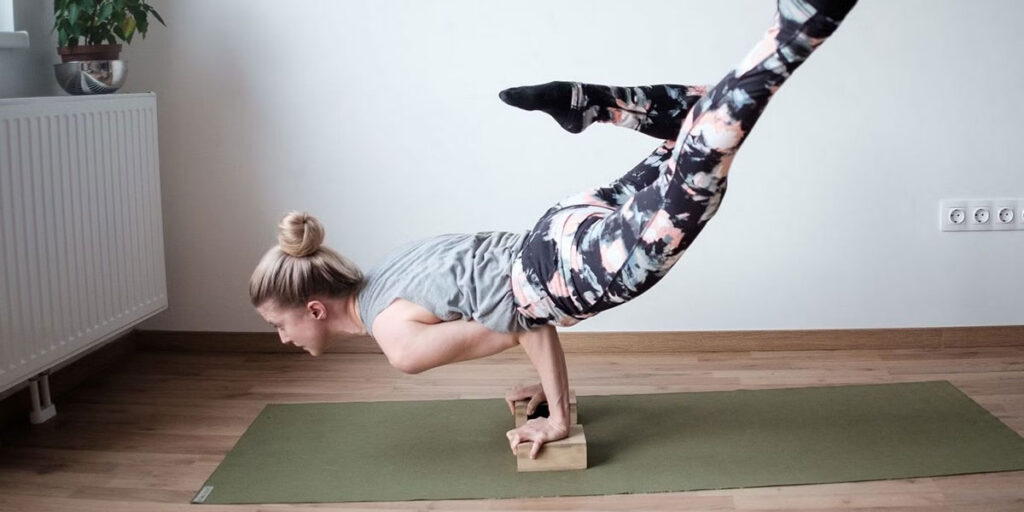14.06.2023 / Leave a Comment
Yoga blocks are essential props that can significantly enhance your yoga practice. They provide stability, support, and alignment assistance, allowing you to deepen your poses and improve your overall practice. When it comes to yoga blocks, there are different materials to choose from, each offering its own unique benefits and characteristics. In this article, we will explore the various materials of yoga blocks and help you determine which one is right for you.
1. Cork Yoga Blocks
Cork yoga blocks are a popular choice among yogis for their natural and eco-friendly properties. Cork is a sustainable material that is harvested from the bark of cork oak trees. It offers a firm yet slightly yielding surface, providing excellent grip and stability. The texture of cork also ensures that your hands and feet stay secure on the block, even during a sweaty practice.
One of the key advantages of cork blocks is their durability. They are resistant to wear and tear, allowing them to maintain their shape and integrity over time. Cork blocks are also lightweight, making them easy to transport to and from your yoga class or when traveling.
Another notable feature of cork blocks is their natural antimicrobial property. Cork is resistant to the growth of bacteria and mold, making it a hygienic choice for your yoga practice. Additionally, cork is a sustainable material, as the extraction process does not harm the trees, which can continue to regenerate their bark.
2. Foam Yoga Blocks
Foam yoga blocks are widely used due to their affordability, versatility, and softness. They are typically made from high-density foam, which provides a comfortable and supportive surface. Foam blocks offer a gentle cushioning effect, making them suitable for individuals with sensitive joints or those who prefer a softer surface.
One of the advantages of foam blocks is their lightweight nature. They are easy to handle and maneuver, allowing you to adjust the height and position of the block according to your needs. Foam blocks also come in various sizes, providing flexibility in terms of the level of support and intensity you require for different poses.
Another benefit of foam blocks is their water-resistant property. This makes them easy to clean and maintain, ensuring they stay hygienic throughout your practice. Foam blocks are also known for their durability, as they can withstand the pressures and demands of regular use.
3. Wood Yoga Blocks
Wood yoga blocks offer a unique and natural feel to your yoga practice. They are typically made from sustainably sourced wood, such as bamboo or birch. Wood blocks provide a firm and stable surface, making them suitable for individuals who prefer a solid and grounded support.
Wood blocks have a beautiful aesthetic appeal and can add a touch of elegance to your yoga practice. They are durable and long-lasting, able to withstand heavy usage without losing their shape or integrity. Wood blocks also have a natural warmth to them, which can be soothing and grounding during your practice.
One thing to consider when using wood blocks is their weight. They are generally heavier than cork or foam blocks, which can make them less portable. However, if you primarily practice at home or in a studio, this may not be a significant concern.
Choosing the Right Material for You
When deciding on the right material for your yoga block, consider the following factors:
- Grip and Stability: Cork blocks provide excellent grip, while foam blocks offer a softer and more cushioned surface. Wood blocks offer a stable and grounded support.
- Durability: Cork and foam blocks are known for their durability, while wood blocks are also long-lasting but may require more care to maintain their condition.
- Weight: Foam blocks are lightweight and easy to carry, while cork and wood blocks are generally heavier.
- Comfort: Foam blocks offer a softer surface, ideal for individuals with sensitive joints. Cork and wood blocks provide a firm and stable support.
- Eco-Friendliness: Cork and wood blocks are sustainable choices, as they come from renewable sources.
Ultimately, the best way to determine the right material is to try out different blocks and see which one feels most comfortable and supportive for your practice. Consider your personal preferences, specific needs, and the type of support you require for different poses.
Knee Pads as an Alternative
In addition to yoga blocks, knee pads can also be a valuable accessory for your practice, especially if you have sensitive knees or find certain poses uncomfortable. Knee pads provide extra cushioning and support, allowing you to comfortably rest your knees on the mat or floor during kneeling poses.
Knee pads are typically made from soft and resilient materials, such as foam or gel. They offer targeted cushioning and pressure relief for your knees, helping to prevent discomfort or strain. Knee pads are lightweight and portable, making them easy to carry in your yoga bag or use during your practice.
When choosing knee pads, look for ones that are specifically designed for yoga or exercise. They should be non-slip, moisture-wicking, and durable to withstand the demands of your practice. It’s also important to select knee pads that provide adequate thickness and support for your knees.
Note: While knee pads can be a useful addition to your practice, it’s essential to listen to your body and modify or adjust poses as needed. Knee pads should not be used as a substitute for proper alignment and technique.
Conclusion
Yoga blocks are valuable props that can enhance your yoga practice by providing support, stability, and alignment assistance. The choice of material for your yoga block is a personal preference based on your specific needs and preferences. Whether you opt for cork, foam, or wood yoga blocks, each material offers its own advantages and characteristics.
Consider factors such as grip, durability, weight, comfort, and eco-friendliness when making your decision. Don’t hesitate to try out different blocks and see how they feel during your practice. Additionally, knee pads can be a beneficial accessory for extra cushioning and support, particularly for individuals with sensitive knees.
Remember to choose high-quality yoga blocks and knee pads that are specifically designed for yoga or exercise to ensure their durability and performance.
If you’d like to explore more about yoga accessories, tips, and techniques, check out our blog for insightful articles and resources to enhance your yoga journey.
Discover Seatwith, a German native D2C brand born to promote sustainable fitness, body and mental health. We offer a range of products for sport, outdoors, and home office, carefully crafted with your comfort in mind. Our brand is all about the ultimate lifestyle experience, helping you live your best life. Check out our collection today and start your journey towards a happier, healthier you!
.



